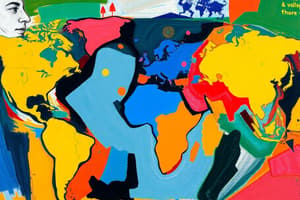Podcast
Questions and Answers
What was the primary goal of the United Nations' Millennium Development Goals?
What was the primary goal of the United Nations' Millennium Development Goals?
- Promoting gender equality and women empowerment
- Eradicating extreme poverty and hunger (correct)
- Achieving universal primary education
- Ensuring environmental sustainability
By what year did the United Nations aim to eliminate extreme poverty for all people?
By what year did the United Nations aim to eliminate extreme poverty for all people?
- 2025
- 2022
- 2015
- 2030 (correct)
Which of the following statements about extreme poverty is true?
Which of the following statements about extreme poverty is true?
- Extreme poverty is defined as living on less than $1.50 a day.
- A person is considered living in poverty in the Philippines if they earn below 100,534 pesos a year. (correct)
- The UN reports that extreme poverty has increased since 2015.
- Economic globalization completely alleviates poverty.
What potential impact does climate change have on global poverty reduction efforts?
What potential impact does climate change have on global poverty reduction efforts?
What does protectionism aim to achieve in relation to foreign trade?
What does protectionism aim to achieve in relation to foreign trade?
What is the main objective of fair trade?
What is the main objective of fair trade?
Which of the following countries is classified as a core country?
Which of the following countries is classified as a core country?
During which historical period did protectionism peak?
During which historical period did protectionism peak?
What does dependency theory primarily analyze?
What does dependency theory primarily analyze?
What economic strategy did Raul Prebisch advocate for Latin America?
What economic strategy did Raul Prebisch advocate for Latin America?
Which of the following best describes semi-periphery nations?
Which of the following best describes semi-periphery nations?
Which economist viewed imperialism from the peripheral perspective?
Which economist viewed imperialism from the peripheral perspective?
Which technology is frequently described as transformative for developing countries?
Which technology is frequently described as transformative for developing countries?
What is NOT a characteristic of the process of globalization?
What is NOT a characteristic of the process of globalization?
Which stage in Walt Rostow's model describes societies focused on food production and exhibiting a strict social hierarchy?
Which stage in Walt Rostow's model describes societies focused on food production and exhibiting a strict social hierarchy?
In which stage of modernization do technological advancements lead to greater job diversity and rising living standards?
In which stage of modernization do technological advancements lead to greater job diversity and rising living standards?
Which of the following characteristics applies to periphery nations?
Which of the following characteristics applies to periphery nations?
During which Rostow stage does intensive growth and industrialization begin to occur?
During which Rostow stage does intensive growth and industrialization begin to occur?
Which region is characterized as having a relatively developed economy but not dominating international trade?
Which region is characterized as having a relatively developed economy but not dominating international trade?
What is the official annual income threshold for someone to be considered living in poverty in the Philippines?
What is the official annual income threshold for someone to be considered living in poverty in the Philippines?
What was the primary aim of the Millennium Development Goals set by the UN?
What was the primary aim of the Millennium Development Goals set by the UN?
What is one factor that the UN identified as a major threat to improvements in global poverty?
What is one factor that the UN identified as a major threat to improvements in global poverty?
Which term refers to a systematic government policy aimed at encouraging domestic production through intervention in foreign trade?
Which term refers to a systematic government policy aimed at encouraging domestic production through intervention in foreign trade?
What was the reported number of people living in extreme poverty three years prior to the 2015 UN report?
What was the reported number of people living in extreme poverty three years prior to the 2015 UN report?
What potential reduction in extreme poverty did the World Bank predict by the year 2030?
What potential reduction in extreme poverty did the World Bank predict by the year 2030?
What defines extreme or absolute poverty, according to the UN?
What defines extreme or absolute poverty, according to the UN?
What economic principle was primarily practiced during the mercantilist era?
What economic principle was primarily practiced during the mercantilist era?
Which of the following is a consequence of trade liberalization?
Which of the following is a consequence of trade liberalization?
Which aspect does fair trade primarily aim to improve?
Which aspect does fair trade primarily aim to improve?
In dependency theory, what is the status of 'core countries' in the world economy?
In dependency theory, what is the status of 'core countries' in the world economy?
What was Raul Prebisch's main stance regarding Latin America's economic development?
What was Raul Prebisch's main stance regarding Latin America's economic development?
What does the term 'semi-periphery nations' refer to?
What does the term 'semi-periphery nations' refer to?
Which statement regarding the Great Depression is accurate?
Which statement regarding the Great Depression is accurate?
What phenomenon allows some developing countries to skip less efficient technologies?
What phenomenon allows some developing countries to skip less efficient technologies?
Which of the following countries is typically classified as a peripheral country?
Which of the following countries is typically classified as a peripheral country?
What is a key focus of Neo-Marxism in relation to imperialism?
What is a key focus of Neo-Marxism in relation to imperialism?
Flashcards are hidden until you start studying
Study Notes
Millennium Development Goals (MDGs)
- Established by the UN in the 1990s to tackle global issues.
- First goal: Eradication of extreme poverty and hunger.
- Other goals include universal primary education, gender equality, child mortality reduction, maternal health improvement, disease combating, environmental sustainability, and global partnership for development.
- Aimed to achieve these goals by 2015.
Poverty Definition and Statistics
- In the Philippines, official poverty threshold: 100,534 pesos/year (~275 pesos/day).
- Extreme poverty defined by the UN: living on less than $1.25/day.
- 2015 UN report indicated 836 million live in extreme poverty, down from 1.9 billion, showing progress.
- World Bank forecasts extreme poverty may drop below 400 million by 2030.
Economic Globalization
- Characterized by increasing interdependence of world economies due to cross-border trade, capital flow, and technology spread.
- Protectionism: Government intervention in trade to support domestic production, often via tariffs and quotas.
- Historical context: Protectionism peaked during the 1929 Great Depression but persists today, with accusations against nations like China, Japan, and the U.S.
- Shift towards trade liberalization post-World War II facilitated by free trade agreements and technological advances, enhancing global trade opportunities.
Leapfrogging and Globalization
- Leapfrogging: Developing countries adopt advanced technologies without going through earlier less efficient stages.
- Mobile phones recognized as transformative technology in developing regions.
- International trade opens up new marketplaces for products and labor, impacting global inequality.
Fair Trade
- Aims for social, economic, and environmental well-being of marginalized producers.
- Focuses on fair pricing, sustainable practices, and safe working conditions.
- Product examples: coffee, bananas, cotton, wine, tea, chocolate.
- In 2006, spending on certified fair trade products reached $2.2 billion, marking a 42% increase from the previous year.
Dependency Theory
- Developed by Raul Prebisch in the 1950s to address global development disparities.
- Distinguishes between core countries (developed) and peripheral countries (less developed).
- Promotes industrialization in peripheral countries to reduce one-sided international trade reliance.
Key Contributors to Dependency Theory
- Andre Gunder Frank: Focused on the impact of imperialism on developing countries.
- Immanuel Wallerstein: Analyzed core-periphery relations and the global division of labor.
Nation Classifications
- Core Nations: Economically dominant with notable influence (e.g., USA, France).
- Semi-Periphery Nations: Intermediate economies, transitioning toward industrialization (e.g., India, South Africa).
- Periphery Nations: Economically weak, least industrialized, heavily influenced by core nations (e.g., Sub-Saharan Africa, Cuba).
Rostow’s Stages of Modernization
- Traditional Stage: Local communities with limited resources; society structured hierarchically.
- Take-Off Stage: Industrialization sparks intensive growth, leading to individual innovation and new markets.
- Technological Maturity: Continued advancement increases living standards and job diversification over time.
- High Mass Consumption: Society produces more goods based on wants rather than needs, often accompanied by social support systems.
Millennium Development Goals (MDGs)
- Established by the UN in the 1990s to tackle global issues.
- First goal: Eradication of extreme poverty and hunger.
- Other goals include universal primary education, gender equality, child mortality reduction, maternal health improvement, disease combating, environmental sustainability, and global partnership for development.
- Aimed to achieve these goals by 2015.
Poverty Definition and Statistics
- In the Philippines, official poverty threshold: 100,534 pesos/year (~275 pesos/day).
- Extreme poverty defined by the UN: living on less than $1.25/day.
- 2015 UN report indicated 836 million live in extreme poverty, down from 1.9 billion, showing progress.
- World Bank forecasts extreme poverty may drop below 400 million by 2030.
Economic Globalization
- Characterized by increasing interdependence of world economies due to cross-border trade, capital flow, and technology spread.
- Protectionism: Government intervention in trade to support domestic production, often via tariffs and quotas.
- Historical context: Protectionism peaked during the 1929 Great Depression but persists today, with accusations against nations like China, Japan, and the U.S.
- Shift towards trade liberalization post-World War II facilitated by free trade agreements and technological advances, enhancing global trade opportunities.
Leapfrogging and Globalization
- Leapfrogging: Developing countries adopt advanced technologies without going through earlier less efficient stages.
- Mobile phones recognized as transformative technology in developing regions.
- International trade opens up new marketplaces for products and labor, impacting global inequality.
Fair Trade
- Aims for social, economic, and environmental well-being of marginalized producers.
- Focuses on fair pricing, sustainable practices, and safe working conditions.
- Product examples: coffee, bananas, cotton, wine, tea, chocolate.
- In 2006, spending on certified fair trade products reached $2.2 billion, marking a 42% increase from the previous year.
Dependency Theory
- Developed by Raul Prebisch in the 1950s to address global development disparities.
- Distinguishes between core countries (developed) and peripheral countries (less developed).
- Promotes industrialization in peripheral countries to reduce one-sided international trade reliance.
Key Contributors to Dependency Theory
- Andre Gunder Frank: Focused on the impact of imperialism on developing countries.
- Immanuel Wallerstein: Analyzed core-periphery relations and the global division of labor.
Nation Classifications
- Core Nations: Economically dominant with notable influence (e.g., USA, France).
- Semi-Periphery Nations: Intermediate economies, transitioning toward industrialization (e.g., India, South Africa).
- Periphery Nations: Economically weak, least industrialized, heavily influenced by core nations (e.g., Sub-Saharan Africa, Cuba).
Rostow’s Stages of Modernization
- Traditional Stage: Local communities with limited resources; society structured hierarchically.
- Take-Off Stage: Industrialization sparks intensive growth, leading to individual innovation and new markets.
- Technological Maturity: Continued advancement increases living standards and job diversification over time.
- High Mass Consumption: Society produces more goods based on wants rather than needs, often accompanied by social support systems.
Studying That Suits You
Use AI to generate personalized quizzes and flashcards to suit your learning preferences.




